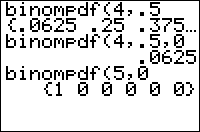TI-BASIC:Binompdf
Command Summary
Calculates the binomial probability, either at a single value or for all values
Command Syntax
for a single value: binompdf(trials, probability, value
for a list of all values (0 to trials) binompdf(trials, probability
Menu Location
Press:
- 2ND DISTR to access the distribution menu
- 0 to select binompdf(, or use arrows.
Press ALPHA A instead of 0 on a TI-84+/SE with OS 2.30 or higher.
TI-83/84/+/SE
2 bytes
This command is used to calculate the binomial probability. In plainer language, it solves a specific type of often-encountered probability problem, that occurs under the following conditions:
- A specific event has only two outcomes, which we will call "success" and "failure"
- This event is going to repeat a specific number of times, or "trials"
- Success or failure is determined randomly with the same probability of success each time the event occurs
- We're interested in the probability that there are exactly N successes
For example, consider a couple that intends to have 4 children. What is the probability that 3 of them are girls?
- The event here is a child being born. It has two outcomes "boy" or "girl". We can call either one a success, but we'll choose to be sexist towards guys and call a girl a success in this problem
- The event is going to repeat 4 times, so we have 4 trials
- The probability of a girl being born is 50% or 1/2 each time
- We're interested in the probability that there are exactly 3 successes (3 girls)
The syntax here is binompdf(trials, probability, value). In this case:
:binompdf(4,.5,3
This will give .25 when you run it, so there's a .25 (1/4) probability out of 4 children, 3 will be girls.
An alternate syntax for binompdf( leaves off the last argument, value. This tells the calculator to compute a list of the results for all values. For example:
:binompdf(4,.5
This will come to {.0625 .25 .375 .25 .0625} when you run it. These are the probabilities of all 5 outcomes (0 through 4 girls) for 4 children with an equal probability of being born. There's a .0625 probability of no girls, a .25 probability of 1 girl, etc.
Advanced (for programmers)
The binompdf( and Binomcdf( commands are the only ones apart from seq( that can return a list of a given length, and they do it much more quickly. It therefore makes sense, in some situations, to use these commands as substitutes for seq(.
Here's how to do it:
- cumSum(binomcdf(N,0 gives the list {1 2 ... N+1}, and cumSum(not(binompdf(N,0 gives the list {0 1 2 ... N}.
- With seq(, you normally do math inside the list: for example, seq(3I2,I,0,5
- With these commands, you do the same math outside the list: 3Ans2 where Ans is the list {0 1 ... 5}.
An example:
:seq(2^I,I,1,5 can be :cumSum(binomcdf(4,0 :2^Ans which in turn can be :2^cumSum(binomcdf(4,0
In general (where f() is some operation or even several operations):
:seq(f(I),I,1,N can be :cumSum(binomcdf(N-1,0 :f(Ans which can sometimes be :f(cumSum(binomcdf(N-1,0
If the lower bound on I in the seq( statement is 0 and not 1, you can use binompdf( instead:
:seq(f(I),I,0,N can be :cumSum(not(binompdf(N,0 :f(Ans which can sometimes be :f(cumSum(not(binompdf(N,0
This will not work if some command inside seq( can take only a number and not a list as an argument. For example, seq(L,,1,,(I),I,1,5 cannot be optimized this way.
Formulas
The value of binompdf( is given by the formula
<math> \operatorname{binompdf}(n,p,k) = \binom{n}{k}\,p^k\,(1-p)^{n-k} = \frac{n!}{k!\,(n-k)!}\,p^k\,(1-p)^{n-k} </math>
This formula is fairly intuitive. We want to know the probability that out of n trials, exactly k will be successes, so we take the probability of k successes - <math>p^k</math> - multiplied by the probability of (n-k) failures - <math>(1-p)^{n-k}</math> - multiplied by the number of ways to choose which k trials will be successes - <math>\binom{n}{k}</math>.
Error Conditions
- ERR:DOMAIN is thrown if the number of trials is at least 1 000 000 (unless the other arguments make the problem trivial)
